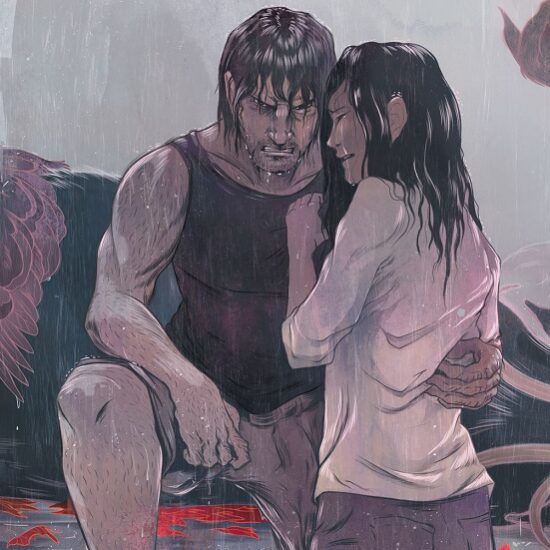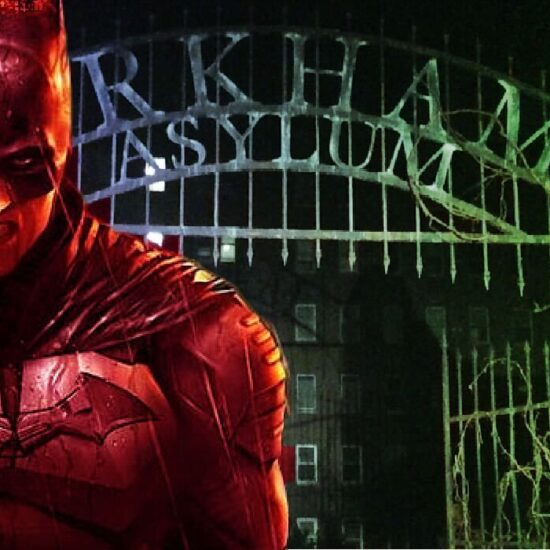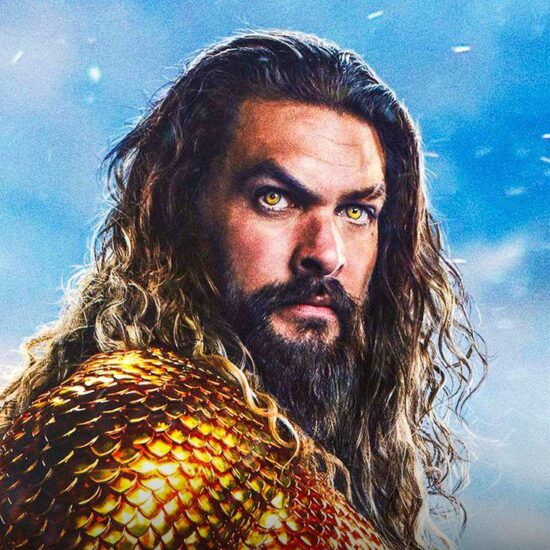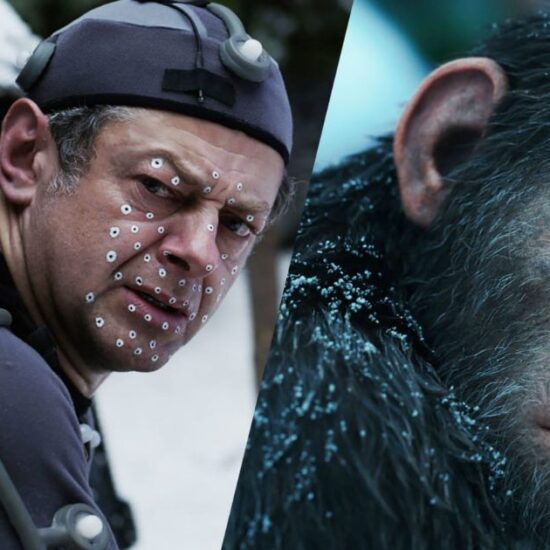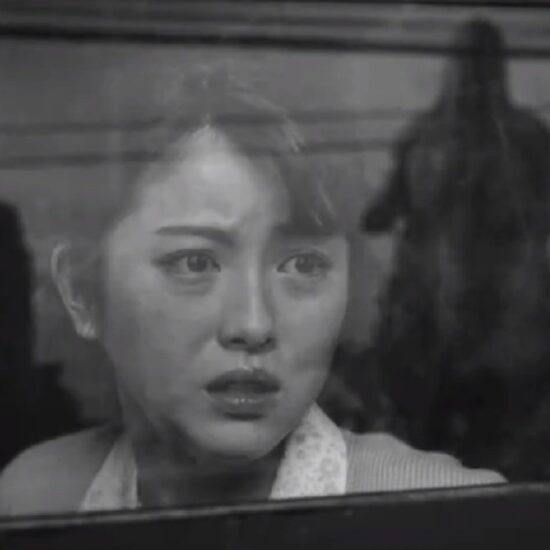
1.3K
There’s no denying that comic books change over time. Characters change and evolve. However, at the core of a character there are essential elements. Some of these elements may revolve around superficial aspects like a costume or a power set. However, it’s the deeper more substantial attributes that tend to hook readers for the long run. If over the course of his 80 plus year history Batman behaved wildly different, or changed his modus operandi readers would drift away, right?
This actually did happen. Batman was on the verge of cancellation until Julius Schwartz righted the ship in the late ’60’s and early ’70’s. Perhaps, the best way to look at this is that the ship was righted and Batman instead of getting cancelled, went on to even greater success when the stories and characterization leaned into the core elements of the character instead of presenting him as a nearly wholly different character walking around in a recognizable costume.
One can’t blame those writers for following the entertainment trends of the era, it only makes sense. Except when it doesn’t; when the approach doesn’t fit the core essentials of the character. Those writers were crafting tales that fit popular trends because it’s what they thought would sell, they were not, however, focusing on the elements that had made Batman popular to begin with. And, this is where we are today.
It’s not hard to see how many of today’s comic book writers are writing for the time and not for the character. It’s not easy to always balance that. You can’t write Batman like he’s still in 1940, unless it’s a period piece of course. The trick is to keep the character grounded at his core while exploring relevant issues that make the story feel contemporary while losing nothing of what makes Batman who he is. Unfortunately, it seems many writers in comics today are making these same mistakes. DC Comics as a whole seems to not understand the difference at times. There are some recent examples we can look at to see what’s going on as we explore what makes a character that character especially ones with a long publishing history.
Alan Scott, The Green Lantern
There are different kinds of changes that can be wrought on a character, marriage, children, death of a loved one, loss of powers, etc….. Sometimes, characters can be reinvented, though it seems that it’s rarely for the better as a reworking that eliminates the core elements of the character most likely will alienate fans of the character. There’s a lot of this going on at DC Comics in a number of titles, and the most recent example is Alan Scott, The Green Lantern. This is easily the most incendiary topic in this editorial. It would’ve been such even had writer Tim Sheridan not gone on X (formerly known as Twitter) to essentially call anyone who did not support the book as a homophobe or bigot. He has actually completely overlooked the larger issue, which is the topic here- Is Tim Sheridan actually interested in the character of Alan Scott and his 80 year history?
Alan Scott first appeared in All-American Comics #16, cover dated, July 1940. That first story presents the origin of The Green Lantern. While there was very little deep or nuanced storytelling during the Golden Age for the character, writers did eventually pair up Alan with an adversary, the Harlequin, a criminal who would not only match wits with the Green Lantern, but who was also interested in his romantic affections. This should be familiar to readers as Batman and Catwoman have had a similar relationship since their first meeting back in Batman #1 (Spring 1940). While Bruce and Selina never dated or got married in the Golden Age, the two flirted with Selina even trying to put aside her criminal ways at times . Batman let her go on more than one occasion because he was so enamored with her, including that first appearance. It wouldn’t be until the Bronze Age that Bruce and Selina got together, got married and had a daughter in continuity. It was the continuity of Earth-Two, but it’s a very similar situation to Alan Scott and Molly (The Harlequin) Mayne.
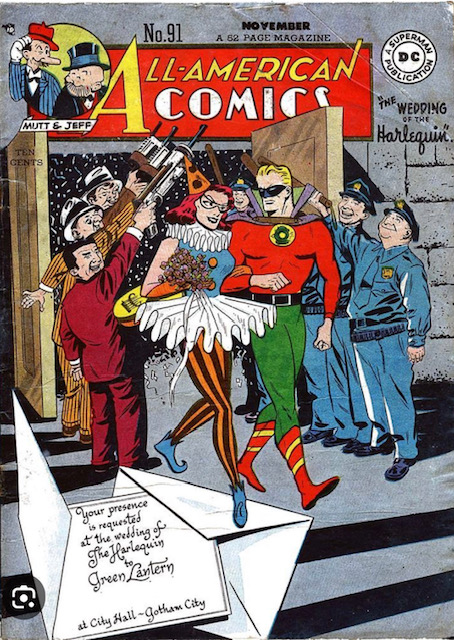
Like the Bat and the Cat, Alan and Molly finally got married in the Bronze Age. Both pairs of characters had a similar dynamic as hero/villain/love interest. Bruce and Selina’s marriage resulted in daughter, Helena Wayne, the Huntress, but ended in tragedy as Selina died trying to protect her family after a false claim by a former confederate. Devastated, Bruce was never the same and died in action a few years later. Alan and Molly got married only after Alan learned that his first marriage had resulted in the birth of twins that his wife had hidden from him. When Alan and Molly got married in their twilight years (Infinity, Inc Annual #1) they had a ready-made family. Not to say it was always easy (Alan had to rescue her soul from Hell at one point), but the couple remained happily married until Flashpoint and the launch of The New 52 in 2011 when all previous DC continuity was restarted.

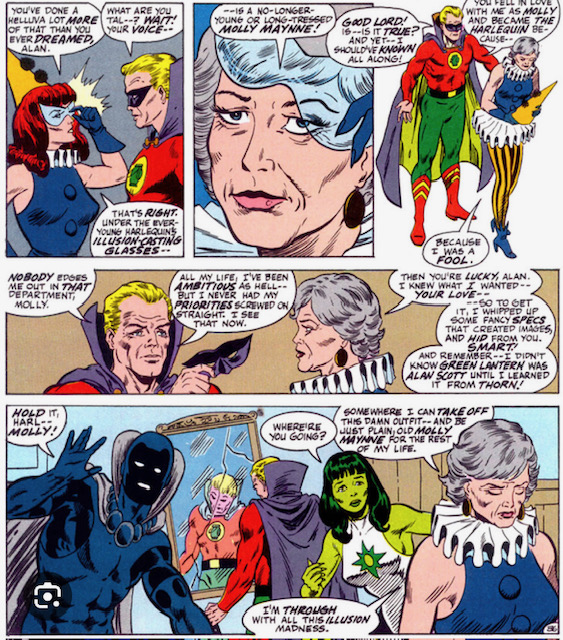
By the time The New 52 launched, fans of Alan Scott had more than a costume and power set to like about the character. Heck, even more than just the fact he was a traditional hero! During the Bronze Age, writers, chiefly Roy Thomas filled in the gaps between the Golden Age and “the present” to develop a more complex Alan Scott with compelling story elements in his long life. Not only had Alan been duped into marrying Rose Canton (the Golden Age Thorn) but he’d fathered two children with her in their short marriage whose existence she’d hidden. It was a surprise to Alan when he found out and it provided a whole new avenue of stories and character nuance to explore. Alan’s relationship with his children Jennie-Lynn (Jade) Hayden and Todd (Obsidian) Rice were central to Alan’s character from the mid ’80’s until Flashpoint in 2011. When Todd was revealed to be gay, it provided a whole other level to the friction between father and son that had been present since their first meeting. Even if it wasn’t intended by creators Roy Thomas and Jerry Ordway, it was a natural interpretation of his character that writer Marc Andreyko seized upon when he outed Todd in Manhunter Volume 3 #18. This insightful reading of the character by Andreyko was not only a contemporary element for inclusion, but yet another addition to Alan Scott’s story that grew the character deeper and more complex. Scott is a man of the 1940’s and homosexuality was viewed very differently than it is today, or in the ’80’s when Rice was first created.
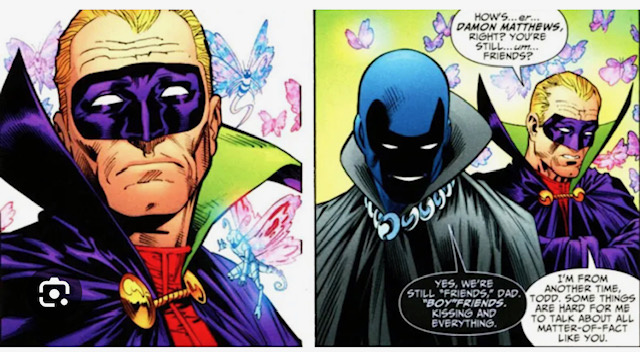
Even outside those aspects of Alan Scott specifically related to his sexual orientation, he was shown in the Bronze Age and beyond to have a very close friend in Jay Garrick, the original Flash. Their bonding extended to their respective wives as well. This was 80 years of storylines and character development when all was seemingly thrown away when James Tynion IV retconned Alan’s sexuality in the Green Lantern 80th Anniversary issue.
With the launch of The New 52, DC Comics presented a new take on the concept of parallel Earths and the multiverse which had played a significant role since its introduction in The Flash #123. In Earth 2 #1 (2012) we meet Alan Scott, a young man unencumbered with any history as he is a brand new version of the character who has yet to become Green Lantern. This Alan Scott is gay. Writer James Robinson wanted to have a gay character since Obsidian had been wiped from existence with Flashpoint. Making Alan Scott this new gay character makes sense in a metatextual way.
The New 52 Earth 2 characters were last seen with any sort of significance in Earth 2: Society #22 in 2017. In a matter of five years, the New 52 Alan Scott was obsolete as DC had already launched the Rebirth initiative with the promise that the original Justice Society of America would return “soon.”
After a time travelling appearance in Justice League #32 (2019), the Justice Society of America including Alan Scott and Power Girl (more on that later) returned not only to continuity, but the present in Doomsday Clock #12. It would’ve seemed that the original Golden Age Green Lantern was back with his history and character intact. It was then a surprise that raised many questions about Alan and his history and family when the aforementioned Green Lantern 80th Anniversary 100-Page Super-Spectacular retconned Alan’s sexuality.
With the publication of Alan Scott: The Green Lantern #1, this mini-series serves to re-contextualize Alan’s history. With that being the purpose, how much are DC Comics interested in the substance of the character of Alan Scott? When you eliminate a character’s history and motivation, relationships etc, what’s the interest in the character then? All that’s left is the superficial aspects, a name, a costume, a power set? Is Alan Scott: The Green Lantern writer, Tim Sheridan actually interested in the attributes that made Alan Scott a founding member of the JSA? The stories that have shaped him? The substance of his character as a founding member of the JSA and one of the first heroes of the DC Universe? The established history with his teammates, and family? Or, is Sheridan interested in the idea of Alan Scott? Is he just a JSA character that can provide representation? Is he invested in the established history and depiction of Alan Scott or simply writing the story of a gay man in the 1940’s?
If the substance of Alan Scott’s history and character attributes are changed is it really still the same character, or is it the substance of a new character wearing the superficial particulars we associate with Alan Scott? We can’t see how much history has changed, because very little has been done with that so far. We’ve seen Jade and Obsidian in Infinite Frontier, but there’s no guarantee they are still in play. The same goes for Molly Mayne-Scott. Is that marriage still something that’s part of these characters’ history? In this recontextualization will we learn that Alan lied and misrepresented himself to both his wives? Is this an heroic action? We’ve seen a retcon in Justice Society of America and The New Golden Age that indicates Molly had a son who has grown up into a character known as The Harlequin’s Son. This is new, so what else has changed? A quick examination of Alan Scott: The Green Lantern #1 depicts what we do know has changed.
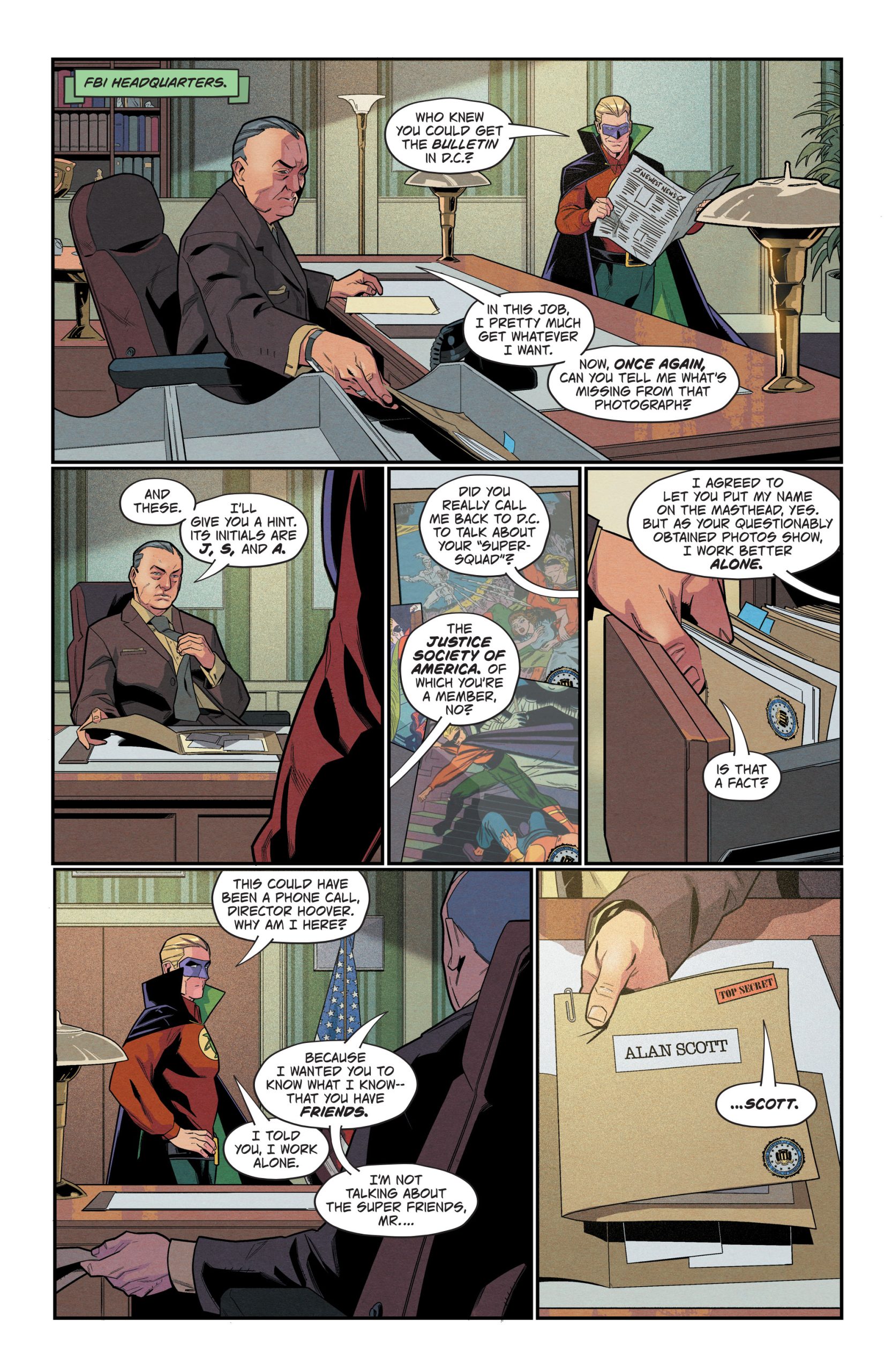
In this first issue, Alan is blackmailed by FBI head J. Edgar Hoover in joining the JSA. This is a massive change from the established origin of the JSA. The JSA formed when British Agent Intrepid asked The Flash, Green Lantern (and Batman in pre-Crisis on Infinite Earths continuity) to help with a mission in Europe which was first told in DC Special #29 (September 1977). It led to all the founding members coming together with a final save of Washington, DC from a special Nazi bomber and stopping the assassination of U.S. President, Franklin Delano Roosevelt. Is this still the JSA’s origin? If so, was Alan Scott involved?

While some of the ideas that Sheridan introduces are compelling and fitting for the story of a gay man from the 1940’s, it doesn’t fit Alan Scott ‘s 80-plus year history. Changing something about a character that fundamentally changes the character’s history and make up does not honor the substance of the character or engage the fanbase that’s built up around the character over the years. For Alan Scott, that’s 80 years. There have been so many stories with so much consistency in Alan’s portrayal, changing things doesn’t genuinely fit. He’s now a reluctant hero not that interested in using his power to fight evil and and is being controlled through blackmail. It’s a change that seems to be there for other reasons and is not pertinent to the core of the character. What if Superman was Superman only because he was being blackmailed over the fact he was an alien. What if that was the mitigating factor in his decision to be on the JL and/ or to be a hero at all?
It’s this that raises my question about Sheridan’s interest and even DC Comics’ interest in the character. It doesn’t make sense to move a character away from the aspects that brought the character appeal over the years. Ignoring these established things in favor for traits that are topical would logically turn fans away as seen with Batman in the ’50’s and ’60’s. It’s something we’ve seen recently with another well established character that has since changed back.
“Ric” Grayson
The reasons behind the “Ric” Grayson era of Nightwing may be different from the motivation for changing Alan Scott’s sexuality, but the results are the same. When Nightwing was struck with amnesia he developed a new personality that severed all his relationships with the Bat-family- Bruce, Alfred, Barbara Gordon, his brother Robins, etc. Not only were these relationships severed, but “Ric” forgot his history and his personality shifted somewhat. Without Dick Grayson as part of the Bat-family, memory of his history or friendships and his past as a blank slate…he was no longer the character people liked. He was no longer the character that appealed to readers. “Ric” was a different character, with a different outlook on things and different relationships. While this direction may have garnered new fans, and kept some, readers were ecstatic to have Dick return.
Essentially, everything people liked about Dick Grayson was gone with “Ric.” Dick is a character that has a long history and to eliminate that takes away what people like about the character. It’s no different than what’s being done with Alan Scott. The change to “Ric” was an in-story change, but the results were the same. This situation is different when compared to Alan Scott because it doesn’t appear that DC or the writers didn’t care about him. Instead, it felt like they wanted to either kill time or have a reason to change his name from “Dick.” It’s important to remember, however, that like Batman before him in the 60’s, readers lost interest in Nightwing because he was divorced from the elements that had made him popular. There are some other DC Comics characters that are suffering the same treatment as Alan Scott.
Power Girl … Paige Stetler ?
Alan Scott isn’t the only JSAer suffering an identity crisis that suggests the writer isn’t really invested in what made the character popular. Power Girl has recently been relaunched in a new eponymously titled ongoing series from DC Comics. Power Girl has been around for nearly 50 years, like Alan Scott, the New 52 resulted in a new version of the character. Unlike Alan Scott, the New 52 version had minor changes to the character. Especially notable is that Power Girl maintained her personality, attitude and a very similar history with one of the most significant aspects being retained, her friendship with Helena Wayne, the Huntress. This is of course the New 52 version of the Huntress who managed to be very similar to her original incarnation with all the essential elements intact. While there is now a third version of Helena Wayne appearing currently in Justice Society of America, it’s her bestie Power Girl who’s suffering at the hands of writer, Leah Williams.
The chief element of Power Girl’s characterization that fans point to for liking the character is her personality. From the outset, she was portrayed as a brash, confident, outspoken young woman. She’s always wanted to be her own and make her own way and not rely on her cousin, Superman. More than anything this has defined her character. Her history after the Crisis on Infinite Earths suffered, but her original origin was returned to her in 2005. Through it all she maintained her personality that had won her fans. It is very perplexing then that despite professing that the Power Girl in current continuity is this original version when the most glaring inconsistency is her personality in this new series by Leah Williams. It’s diametrically opposed to what readers have come to love about the character. It’s like seeing Batman as a snarky, wise-cracking, bombastic street acrobat. It just isn’t who the character is. Furthermore, the writing itself contradicts the stories that are referenced in the comics themselves as well as the official DC Comics blog that servers as a primer for readers on the character and this series.
The blog states that this version of Power Girl is the original pre-Crisis on Infinite Earths, Earth-Two version. It references her first appearance in All-Star Comics #58, her changing back story and return to form in JSA: Classified. What’s confounding is that while these new stories by Leah Williams reference her past, including the Karen Starr identity and supposedly her job as a Tech company entrepreneur, Williams doesn’t appear to understand the substance of them.
In the back up stories from Action Comics #1051-1053, PG is being attacked by Johnny Sorrow. He claims that he and Power Girl are the last two survivors from their universe. If PG is from the original Earth-Two, this doesn’t make any sense. It’s well established that Psycho-Pirate is the only other survivor from Earth-Two as well as the only one who remembered the Multiverse for decades after the Crisis on Infinite Earths wiped out the multiverse. Furthermore, Johnny Sorrow was never an Earth-Two character. He appeared in Earth 2: Society, but the blog makes it clear that the Earth 2/ New 52 Power Girl is a different character, and these new stories aren’t about her. In fact, Johnny Sorrow made his first ever appearance anywhere in New Earth continuity (post-Crisis, post-Zero Hour) in Secret Origins of Super-Villains 80 Page Giant #1, (December 1999). He would have no memory of any life on Earth-Two, since he never appeared in that continuity.
The blog explains that Power Girl was raised in a simulation on her symbioship, however the title scrawl from Power Girl #1 says she was sent to Earth to watch over baby Kal-L. Both Kryptonians were sent as infants so PG could certainly not look after baby Kal-L as she was a baby herself. Her ship took longer to arrive, and thus she was raised by it arriving on Earth as a young woman when it took longer than anticipated.
The blog states that she doesn’t wear the “S” symbol because she didn’t work long with Superman on Earth-Two. This is patently false for a number of reasons. Her reason for not wearing the “S” can be found in All-Star Comics #64, her 7th appearance ever as seen in the image below.
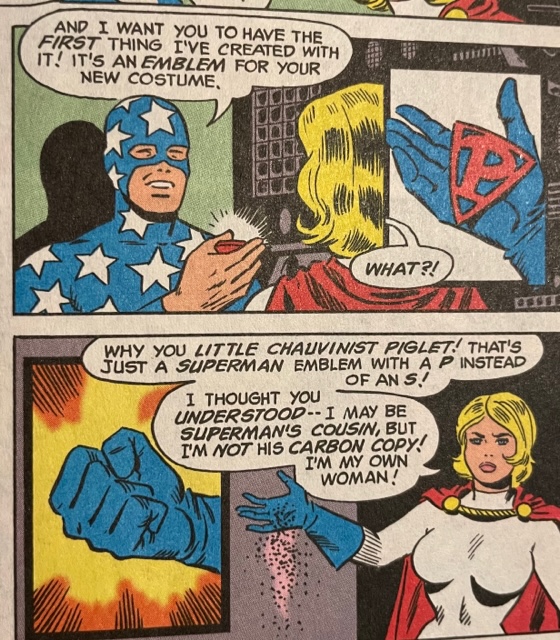
And interestingly, the blog clearly indicates that the All-Star Comics stories are part of her past, a past that did include time together plus she made the decision about the “S” BEFORE she revealed herself to the world. Also, the title scrawl mentioned above claims she DID work along side Superman.
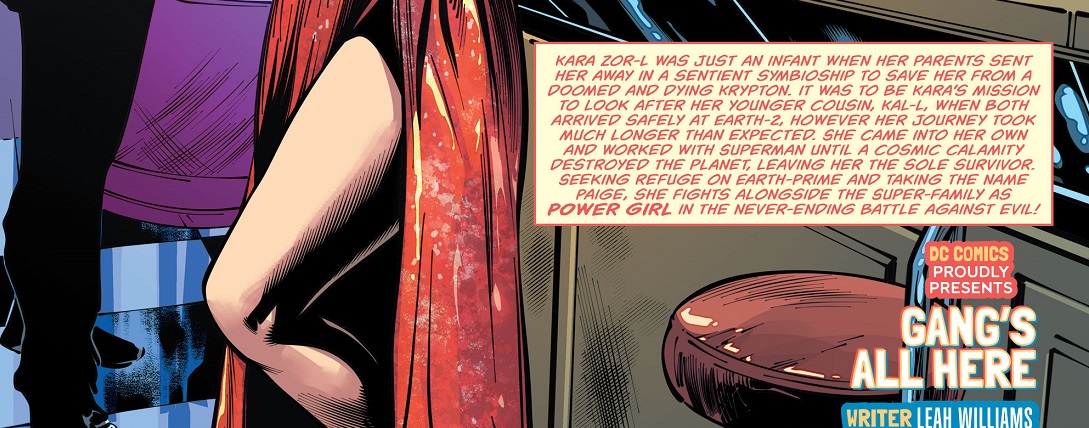
One of the most curious and off-putting aspects of Power Girl’s portrayal in this series is her 180 degree personality shift. The blog claims the biggest thing for PG is her identity:
“A Power Girl so far removed from her point of origin, so many worlds and continuities away, that anyone would have a hard time telling who she’s really supposed to be—much less herself. This is a Power Girl who needs to undergo some serious soul searching to find out what she’s really about, which is where we find her today.”
It’s not clear how PG got to this point. We have the Karen Starr identity referenced so we know that part of her history is intact. The blog says she has returned with the rest of the JSA during Doomsday Clock. The quote from the blog above tries to make readers believe that she’s having some sort of identity crisis, but as it states elsewhere in blog, that was resolved in Infinite Crisis and the JSA: Classified storylines. Leah Williams suggests these identity issues in her stories, but never explains how PG went from a confident, independent woman insecure, unsure of herself and dependent on Superman for an identity (she wears the “S” now). When did that happen? It’s diametrically opposed to how she’s always been portrayed. It doesn’t make sense and it appears that Williams (and blog writer Alex Jaffe) isn’t aware of the substance of the character. To Williams she’s just an alternate Supergirl, instead of a distinct character that has always behaved differently from the main universe Supergirl. In fact, it appears that is the length and breadth of Williams’ understanding of Power Girl.
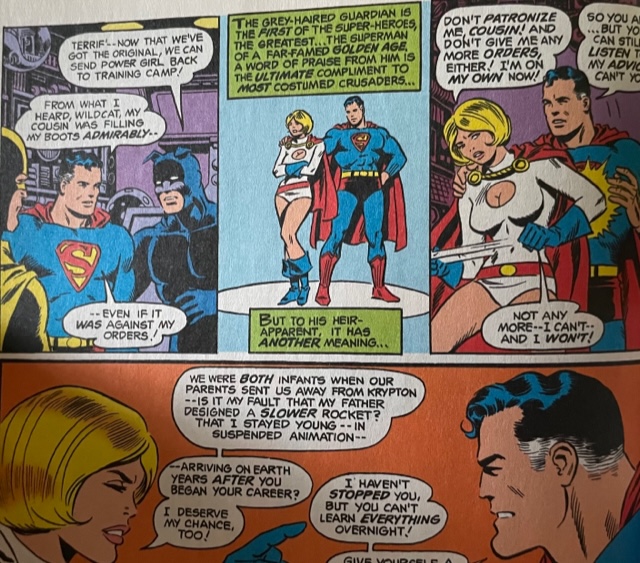
There’s another bizarre quality to Williams’ portrayal of Power Girl. She writes Power Girl like she’s new to Earth, like her rocket landed, she met Kal-L and a few days later found herself lost and showed up on the main DC Earth. She seems wholly unconnected with her past with the JSA which is currently on display in Justice Society of America which is currently publishing. That book acknowledges Power Girl’s past and provides a depiction that is in line with her established personality.
The question remains: Is Leah Williams actually interested in Power Girl as a character? Does she understand anything about her history or personality? These are the elements that won Power Girl fans over the years. Williams seems to be ignoring them outright, or she’s just ignorant of them to begin with and has made no attempt to make them make sense. Either way, it points to a lack of interest in the character other than the most basic superficial description, simply an alternate Supergirl, like Sheridan’s Alan Scott, a version of the character that doesn’t utilize the history of the character and shows no interest in the substance of the character.
And, There’s More…
This situation isn’t confined to Power Girl and Alan Scott. The new Wonder Woman series from Tom King’s pen indicates much the same. King is known for his controversial takes on characters, more often that not bending characters to fit the stories he wants to tell. The new Wonder Woman is no different, and in this case the intent from the outset seems less rooted in an interest in Wonder Woman, but a desire to tell a story that requires great leaps in status quo and characterization to make work. When did all those Amazons emigrate to the U.S.? Are there even enough Amazons on Themiscrya to be statistically significant even if they ALL moved to the U.S.? Why would Diana sit by and wait if the killer was identified as an Amazon immediately? Why wouldn’t she investigate immediately? The real reason is that that is not the story King wants to tell. He doesn’t even seem to want to tell the story from Diana’s POV as The Sovereign is narrating the tale. Very little so far indicates that King is interested in Wonder Woman outside the broadest definition of her.
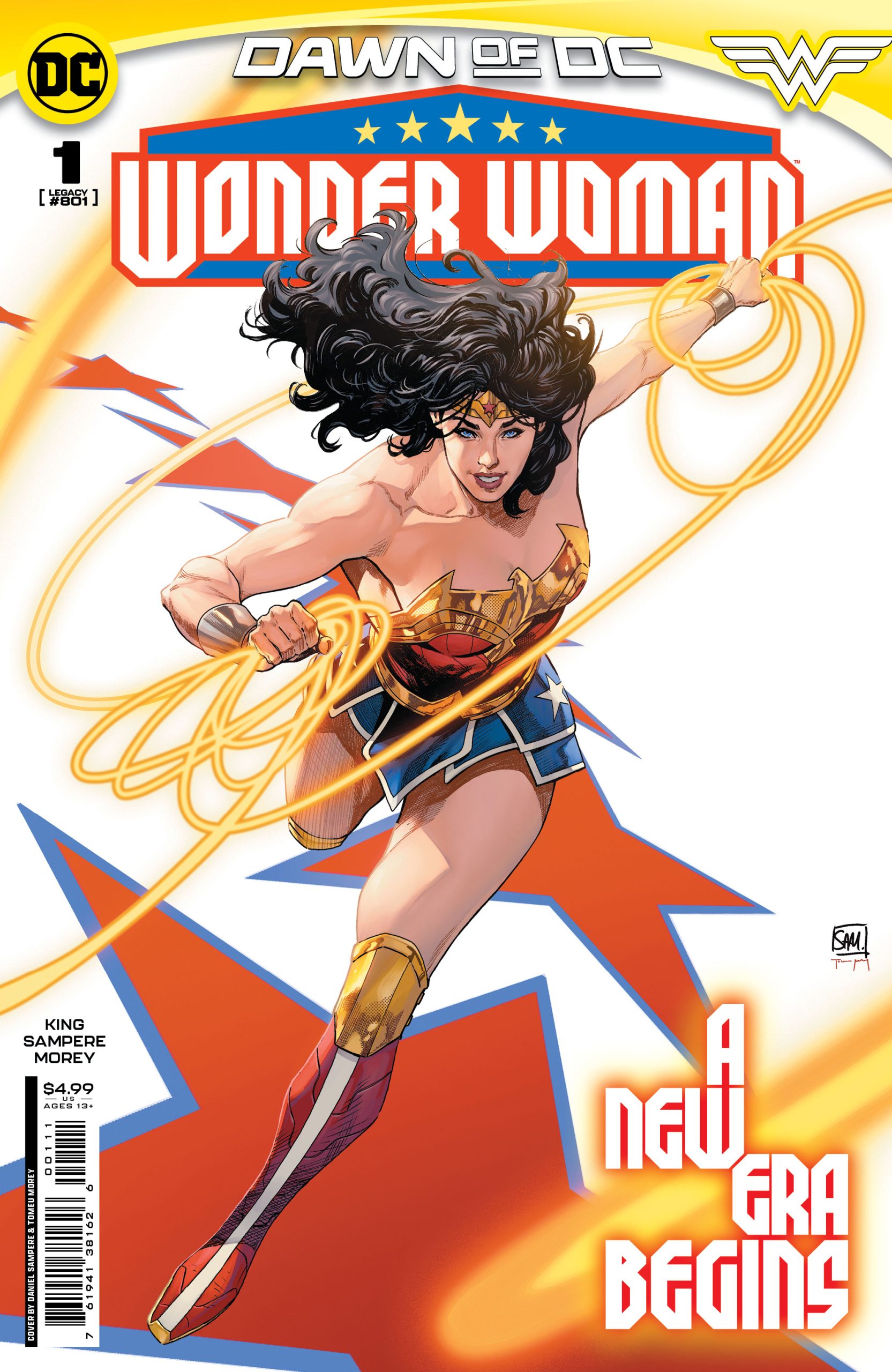
It’s not new though, Human Target depicted all the Justice League International characters wildly out of character except for Guy Gardner. He was already broken so King didn’t have to break him. Strange Adventures turned the hero, Adam Strange into the villain. King does it in nearly all of his stuff, the most notable outlier being Superman, “Up in the Sky” which perfectly depicts the Man of Steel. If a writer has to change the fundamentals of a character is his/her interest really in the character or the idea of the character?
Even the new Birds of Prey comic doesn’t seem to really be interested in the core concept of the Birds of Prey. Kelly Thompson is approaching the book like the concept is just a team of women. She isn’t including founder Barbara Gordon, or centering the series on the relationship between Barbara, Dinah (Black Canary) and Helena (Huntress) Bertinelli. In fact, Dinah is the only one of these characters in the comic. Combined with the fact that the series reads like Thompson was looking for an excuse to write Harley Quinn, a character who has zero business being involved with the Birds of Prey, it again appears that the writer isn’t actually interested in what the made the Birds of Prey concept popular to begin with. Instead, it’s being rebranded as something else, which would indicate that this rebranding is what Thompson is actually interested in and not the substance of the concept as it was developed over the years. For Thompson, Birds of Prey is just a team of women characters, and again that’s the absolute basic definition of the concept with no substance.
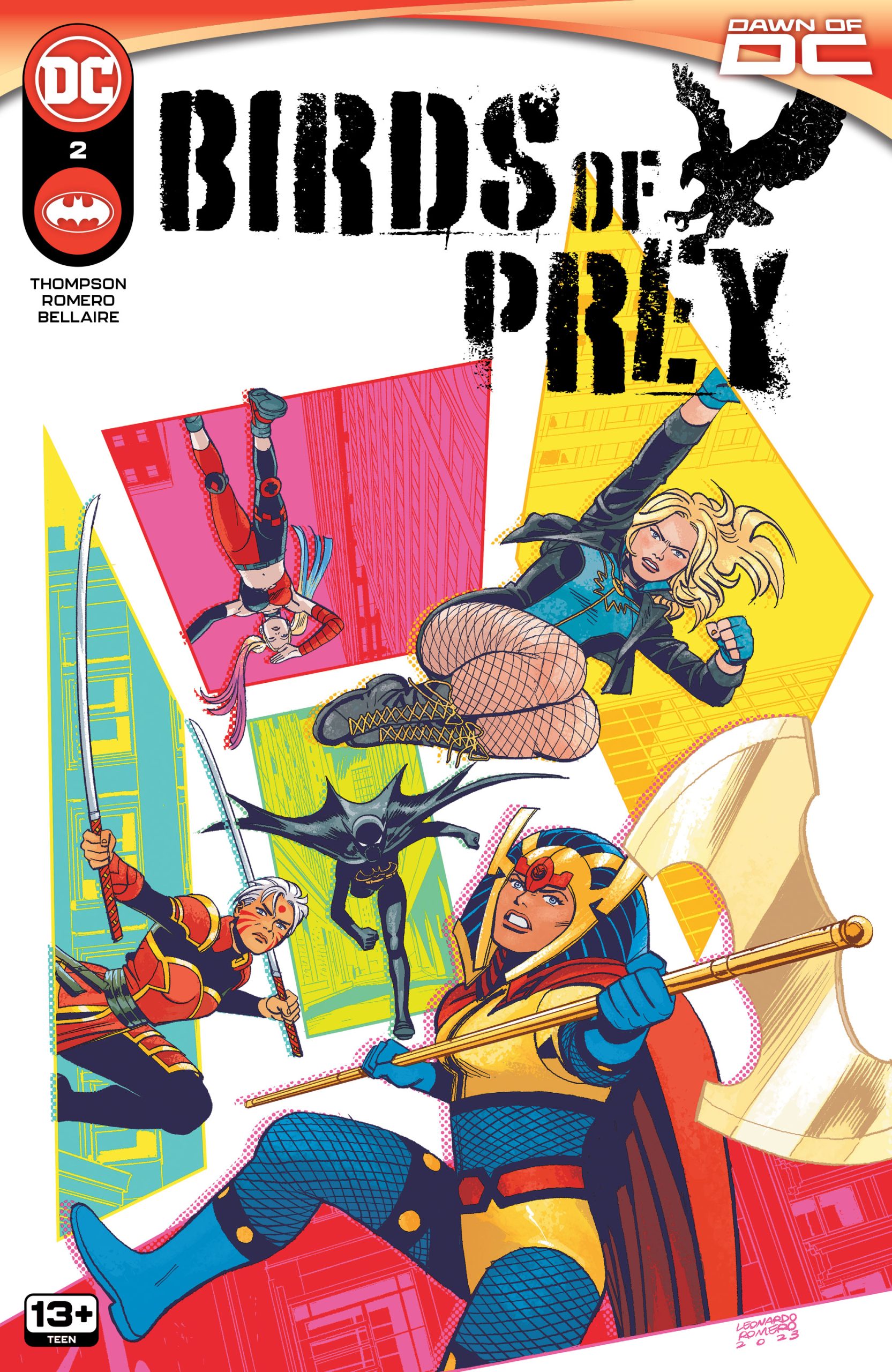
The Balance Between Character and Story … Both Matter
I won’t say that some of the the stories mentioned above don’t have compelling aspects. However, the big question is whether or not they work for the characters with which they are associated. At one point comic book writers understood they were writing characters. Characters that had histories, personalities, ways of operating…. Readers were following these characters because of how they had been built up and developed over he years. Readers followed the continuing stories because they were invested in the substance of the characters. Like people in the real world, we are attracted to substance, not color, gender or any other superficial element. It’s the person inside that matters, and if that changes, that’s when relationships break down.
Even Alan Moore when writing Watchmen created his own characters instead of using the recently acquired Charlton characters that he had originally intended to use. That story would have destroyed them for further inclusion in the DC Universe. And, that’s what a lot of these writers are doing. Adam Strange can’t be used in the DC Universe if Strange Adventures is “in continuity.” The same goes for the characters in Human Target. Everything readers liked about Power Girl has been removed from her characterization. Fans just want to forget this run already, especially since they are getting the Power Girl they love over in Justice Society of America. Alan Scott is completely out of step with his history and characterization and Sheridan’s aspersions about the JSA make this series inaccessible to existing fans of the team and Alan Scott.
Creating new characters is the best option if one is not actually interested in existing characters but just the ideas of the characters and not the substance of the characters that have been developed through the years. There’s got to be a balance. Create a new character if necessary to tell a story, but don’t destroy or bend existing characters unrecognizably in order to tell a story. We can only hope that some of these takes get cancelled and return the characters who were beloved to begin with. We can also hope that writers will have the opportunity and means to tell their stories in a manner that will allow them to be judged on their own merit. With long standing characters it’s difficult to separate the quality of the story, the writing, the themes if they do not fit the character. It’s a balance, and the pendulum is swinging away from the importance of the substance of characters to simply the broadest definitions of them leaving the stories that MADE these characters left out in the cold.










